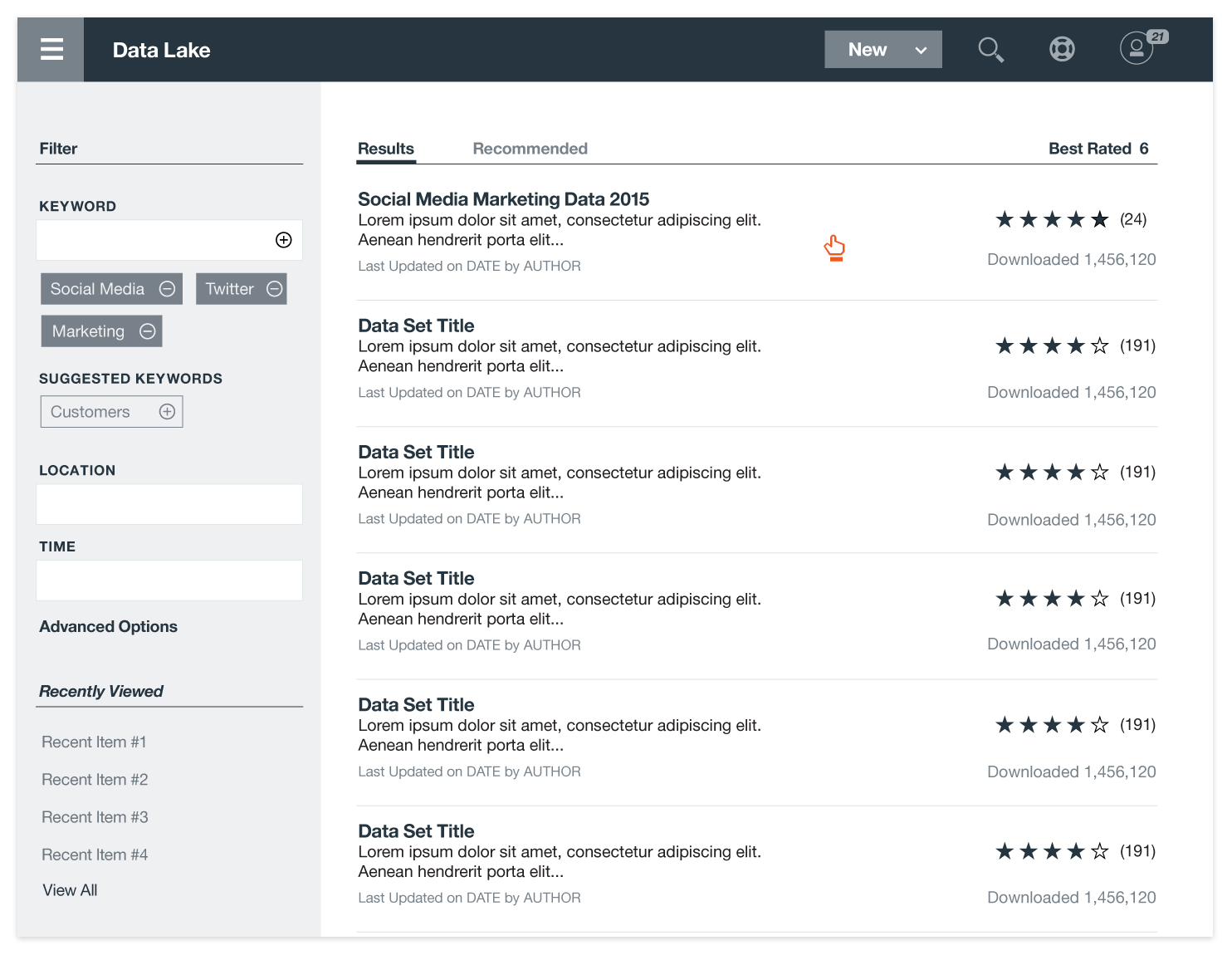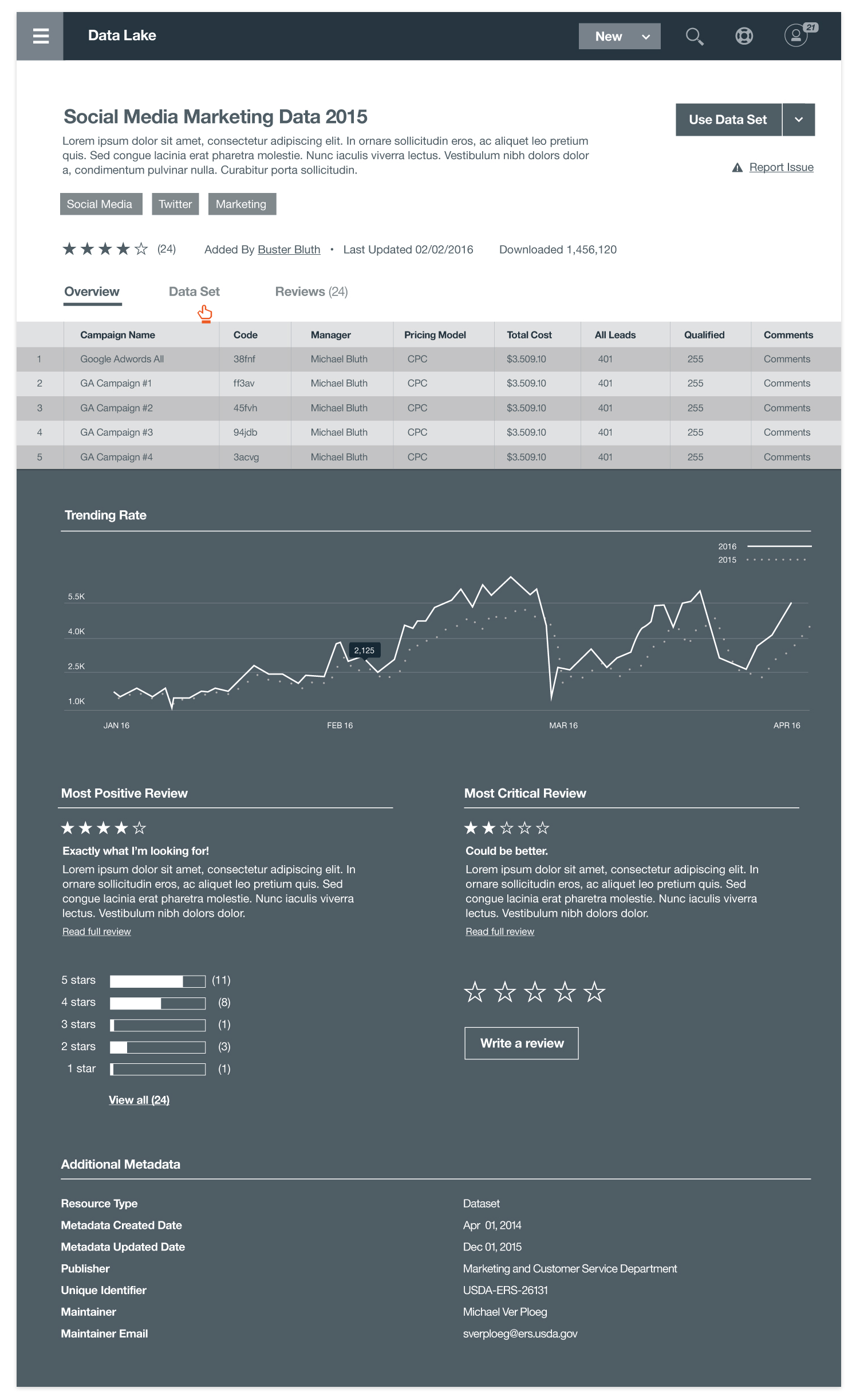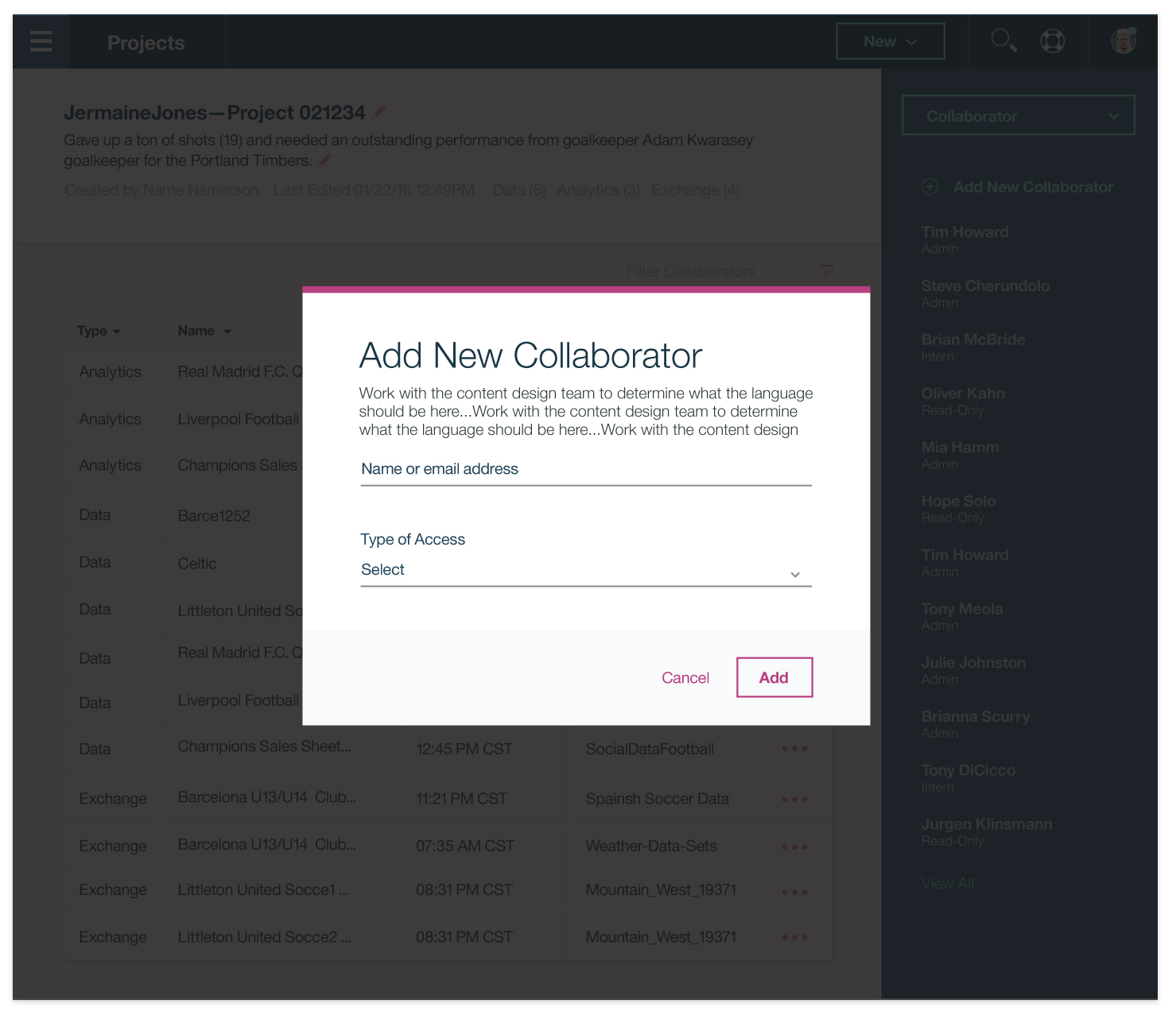IBM Data Lake
A data management hub that guides data scientists and business analysts to meet their Big Data needs; driving new insights through a suite of analytic products (like IBM Dataworks Lift) from a connection of APIs.
Learn more about IBM Data Lake.
WHAT DOES IT LOOK LIKE:
![]()
![]()


WHY IBM DATA LAKE?
Enterprise businesses sit on millions of data points about their customer’s behaviors, spending habits, personal information, etc. Without a manner to analyze these ‘Big Data’ points, companies miss the ability to translate data to quality experiences that drive customer loyalty and an increase in revenue.
CHALLENGES THAT EXISTED:
- Newly aquired Softlayer needed to be integrated into the platform
- New, distributed team: Product in Boston, Design in Austin and IT in Germany
- Design team was brand new to the subject of Big Data
- Behavioral personas being created in tandem with prototypes
- Brand new IBM Analytics Design Language System
OUR PROBLEM TO SOLVE:
How might we ... design an MVE that meets the core needs of data scientists while delivering before IBM Think Conference?
OUR PROCESS:
Design Research ︎ Design Strategy ︎ Wireframes ︎ ︎ High-Fidelity Visuals
👨👨👧👦 Design Research
THE PRACTICE OF DESIGN RESEARCH AT IBM:
Designing great products starts with a deep understanding that: although you may have deep expertise in your domain — you are NOT your user.
IBM Design Research reinforced this notion along with establishing design research principles and best practices to guide product & service teams.
![]()
While we must know our users and their behaviors, it’s important to note that teams will never have 100% knowledge of their user before they release a product into market. You will always carry tension of ... “do we have ‘just enough research’ to make an informed business decisions”?
![]()
![]() Depending on the phase of work, teams will conduct research to better understand their users
Depending on the phase of work, teams will conduct research to better understand their users
IBM ANALYTICS | PERSONAS:
Our teammate Viriginia Honig did the lionshare of the research with our target users, creating reports and shareouts to help the UX/UI team develop more empathy for those that would use our product.
![]()
![]()
![]()
Designing great products starts with a deep understanding that: although you may have deep expertise in your domain — you are NOT your user.
IBM Design Research reinforced this notion along with establishing design research principles and best practices to guide product & service teams.

While we must know our users and their behaviors, it’s important to note that teams will never have 100% knowledge of their user before they release a product into market. You will always carry tension of ... “do we have ‘just enough research’ to make an informed business decisions”?

 Depending on the phase of work, teams will conduct research to better understand their users
Depending on the phase of work, teams will conduct research to better understand their usersIBM ANALYTICS | PERSONAS:
Our teammate Viriginia Honig did the lionshare of the research with our target users, creating reports and shareouts to help the UX/UI team develop more empathy for those that would use our product.



🎯 Design Strategy
In true Agile form, our team was not only designing the data management hub, but also experiences that could feed as an API into the hub.
To inform our strategy, we held a workshop to align on the As-Is, To-Be and Roadmap of the experience ... leveraging behavioral personas from Virginia.
We also surfaced risky unknowns and assumptions to ensure we prioritized the most important areas to reduced the risk of being wrong.


🙆🏻♂️: James Lewis & John Howrey faciliating the workshop

Reducing steps from As-Is to To-Be scenarios
🖼 Wireframes
Once the design strategy was defined, our design team used rapid concepting and low-fidelity prototypes to explore how the experience would function. IBM DATAWORKS LIFT:
![]()
![]()
IBM DATA LAKE:
![]()
![]()


IBM DATA LAKE:


🎨 High-Fidelity Visuals
I designed 100’s of different variations to the Dataworks Lift experience before aligning on the solution that was in-step with IBM Analytics style guide.Additionally, we explored how the Data Lake would look and feel using repeatable design components.
IBM DATAWORKS LIFT:
![]()
IBM DATA LAKE:
![]()
![]()
![]()
![]()
![]()

IBM DATA LAKE:





MY ROLE:
I was visual designer on the IBM Data Works & IBM Data Lake from wireframes to hi-fidelity prototypes.
ADDITIONAL CONTRIBUTORS:
Research Leads: Virginia Honig & Frances DiMare
Research: Stella Lee, Alex Simmon, Tina Zeng, McKenzie Carlile, Michael Bush, Meghan Corbett, Nishita Muhnot
UX: Russell Parrish, James Lewis
Visual: Noelle Hoffman, Hala Shih, Tim White
Design Manager: Ty Tyner
Design Executive: Joe Meersman
OUTCOMES:
I left IBM during the development of the MVP, so I don’t have specific outcomes of the product ︎
KEY LEARNINGS:
- Design team has to be in-step with research teammates. We wouldn’t see them for weeks and then would get a data dump.
- At IBM, visual designers often put lipstick on the pig. UX/Visual should be the same role — not seperate roles.
- A quality design producer is worth their weight in gold. There were no producers at IBM, which meant designers spent less time doing the things they brought the most value towards.